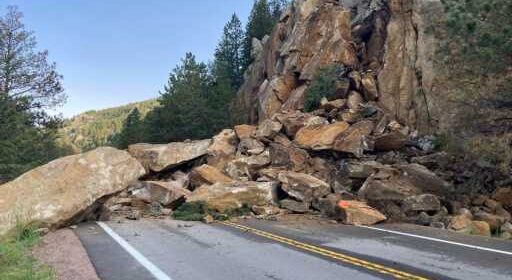Snowy winter, wet spring raise risk of rockslides CDOT warns

Recent rains and heavy snows in the winter could mean more rockslides and mudslides are imminent in Colorado.
While the Colorado Department of Transportation has traditionally relied on road maintenance crews to flag them to slopes that might need mitigation to prevent a slide, travelers now can help with this effort.
A rockfall reporting tool is a new feature in CDOT’s COtrip mobile app lets motorists and other travelers easily share information about rocks and other debris on the road with the agency.
“Our primary source in the past has been maintenance crews and the additional information we can get now is helpful,” said Bob Group, geohazards program manager with CDOT. “The public can report rockfall when seen on the highway.”
At least one large slide has already happened in Colorado. On Wednesday a slide with stones the size of vehicles and weighing tons swept across Colorado 7 west of Lyons and shut down the road. While no one was injured in the incident, a cleanup expected to last through June 20 is underway.
With abundant snowfall in the mountains this winter and early spring, followed by heavy, widespread and prolonged rains in the north and central mountains over the past couple of months, rockslides, along with mud, land and debris slides, could tick up in upcoming weeks.
“There is potential for rockslides in a lot of the steep-walled rock canyons that exist throughout Colorado,” Group said.
A troubled spot for such slides in recent years has been on Interstate 70 through Glenwood Canyon where rock and mudslides, along with flash floods, shut down the highway multiple times after the 2020 Grizzly Creek Fire scorched 51 square miles around the canyon.
“Glenwood Canyon is certainly an obvious place where you have all the right ingredients” for potential slides, said Matt Inzeo, CDOT communications director. “You have all the common elements, snowfall and runoff during the year. It’s not uncommon for us to be doing special (mitigation) checks in the area.”
Colorado 7 remains closed as cleanup and rock removal is underway. Members of CDOT’s geohazards program will investigate the rockslide, determine where the slide started and what caused the slide, and examine the mountainside slope for unstable areas in the wake of the slide. If necessary, crews will take measures to stabilize spots that could be potentially dangerous.
“The rain was definitely a contributing factor” in the Colorado 7 slide, Group said. “But it’s not as simple as one big rainstorm and you get a failure like that. Natural erosion takes place over a number of years.”
Abundant and widespread snowfall in the mountains this season followed by recent prolonged rainfall could raise the chance for upcoming rockfalls and landslides.
“It’s been a heavy snow year with a higher than average run off, coupled with pretty significant and heavy rain this spring, we’ve been seeing a higher level of activity across the state,” Group said.
Even with reports and precautions, it’s important to recognize that “geohazards are sporadic and unpredictable,” according to CDOT’s website.
Crews perform rockslide mitigation in rock scaling operations around the state. One project underway is in Pitkin County along Colorado 133 south of Redstone. As crews work to make 133 safe, drivers can expect delays in June of up to 60 minutes.
Highway officials urge drivers to be patient and attentive as they travel.
“Be aware as drivers, be ready to act,” Group said. “It’s the same as watching out for wildlife, just pay attention and be aware.”
Get more Colorado news by signing up for our daily Your Morning Dozen email newsletter.
Source: Read Full Article
